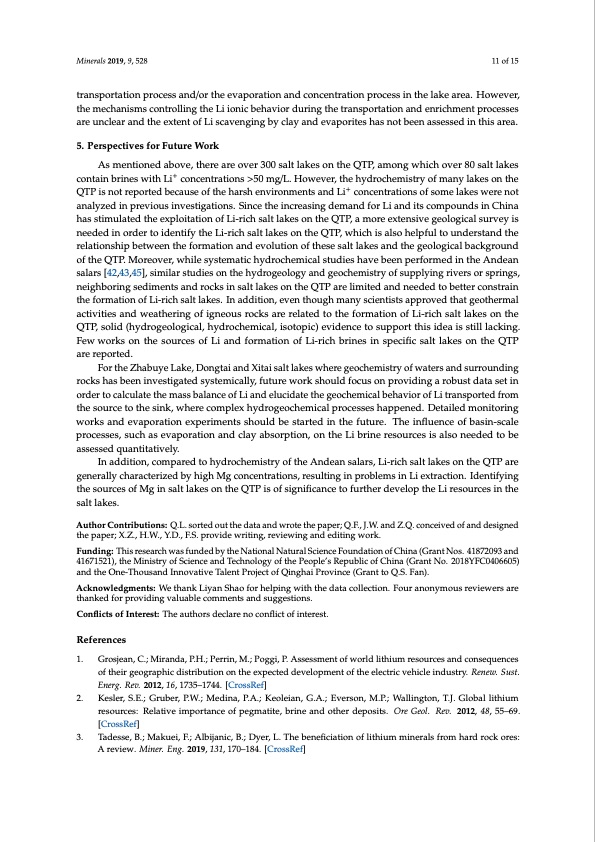
PDF Publication Title:
Text from PDF Page: 011
Minerals 2019, 9, 528 11 of 15 transportation process and/or the evaporation and concentration process in the lake area. However, the mechanisms controlling the Li ionic behavior during the transportation and enrichment processes are unclear and the extent of Li scavenging by clay and evaporites has not been assessed in this area. 5. Perspectives for Future Work As mentioned above, there are over 300 salt lakes on the QTP, among which over 80 salt lakes contain brines with Li+ concentrations >50 mg/L. However, the hydrochemistry of many lakes on the QTP is not reported because of the harsh environments and Li+ concentrations of some lakes were not analyzed in previous investigations. Since the increasing demand for Li and its compounds in China has stimulated the exploitation of Li-rich salt lakes on the QTP, a more extensive geological survey is needed in order to identify the Li-rich salt lakes on the QTP, which is also helpful to understand the relationship between the formation and evolution of these salt lakes and the geological background of the QTP. Moreover, while systematic hydrochemical studies have been performed in the Andean salars [42,43,45], similar studies on the hydrogeology and geochemistry of supplying rivers or springs, neighboring sediments and rocks in salt lakes on the QTP are limited and needed to better constrain the formation of Li-rich salt lakes. In addition, even though many scientists approved that geothermal activities and weathering of igneous rocks are related to the formation of Li-rich salt lakes on the QTP, solid (hydrogeological, hydrochemical, isotopic) evidence to support this idea is still lacking. Few works on the sources of Li and formation of Li-rich brines in specific salt lakes on the QTP are reported. For the Zhabuye Lake, Dongtai and Xitai salt lakes where geochemistry of waters and surrounding rocks has been investigated systemically, future work should focus on providing a robust data set in order to calculate the mass balance of Li and elucidate the geochemical behavior of Li transported from the source to the sink, where complex hydrogeochemical processes happened. Detailed monitoring works and evaporation experiments should be started in the future. The influence of basin-scale processes, such as evaporation and clay absorption, on the Li brine resources is also needed to be assessed quantitatively. In addition, compared to hydrochemistry of the Andean salars, Li-rich salt lakes on the QTP are generally characterized by high Mg concentrations, resulting in problems in Li extraction. Identifying the sources of Mg in salt lakes on the QTP is of significance to further develop the Li resources in the salt lakes. Author Contributions: Q.L. sorted out the data and wrote the paper; Q.F., J.W. and Z.Q. conceived of and designed the paper; X.Z., H.W., Y.D., F.S. provide writing, reviewing and editing work. Funding: This research was funded by the National Natural Science Foundation of China (Grant Nos. 41872093 and 41671521), the Ministry of Science and Technology of the People’s Republic of China (Grant No. 2018YFC0406605) and the One-Thousand Innovative Talent Project of Qinghai Province (Grant to Q.S. Fan). Acknowledgments: We thank Liyan Shao for helping with the data collection. Four anonymous reviewers are thanked for providing valuable comments and suggestions. Conflicts of Interest: The authors declare no conflict of interest. References 1. Grosjean, C.; Miranda, P.H.; Perrin, M.; Poggi, P. Assessment of world lithium resources and consequences of their geographic distribution on the expected development of the electric vehicle industry. Renew. Sust. Energ. Rev. 2012, 16, 1735–1744. [CrossRef] 2. Kesler, S.E.; Gruber, P.W.; Medina, P.A.; Keoleian, G.A.; Everson, M.P.; Wallington, T.J. Global lithium resources: Relative importance of pegmatite, brine and other deposits. Ore Geol. Rev. 2012, 48, 55–69. [CrossRef] 3. Tadesse, B.; Makuei, F.; Albijanic, B.; Dyer, L. The beneficiation of lithium minerals from hard rock ores: A review. Miner. Eng. 2019, 131, 170–184. [CrossRef]PDF Image | Lithium-Rich Brines in Salt Lakes on the Qinghai-Tibetan

PDF Search Title:
Lithium-Rich Brines in Salt Lakes on the Qinghai-TibetanOriginal File Name Searched:
minerals-09-00528.pdfDIY PDF Search: Google It | Yahoo | Bing
Product and Development Focus for Infinity Turbine
ORC Waste Heat Turbine and ORC System Build Plans: All turbine plans are $10,000 each. This allows you to build a system and then consider licensing for production after you have completed and tested a unit.Redox Flow Battery Technology: With the advent of the new USA tax credits for producing and selling batteries ($35/kW) we are focussing on a simple flow battery using shipping containers as the modular electrolyte storage units with tax credits up to $140,000 per system. Our main focus is on the salt battery. This battery can be used for both thermal and electrical storage applications. We call it the Cogeneration Battery or Cogen Battery. One project is converting salt (brine) based water conditioners to simultaneously produce power. In addition, there are many opportunities to extract Lithium from brine (salt lakes, groundwater, and producer water).Salt water or brine are huge sources for lithium. Most of the worlds lithium is acquired from a brine source. It's even in seawater in a low concentration. Brine is also a byproduct of huge powerplants, which can now use that as an electrolyte and a huge flow battery (which allows storage at the source).We welcome any business and equipment inquiries, as well as licensing our turbines for manufacturing.| CONTACT TEL: 608-238-6001 Email: greg@infinityturbine.com | RSS | AMP |